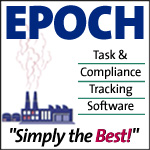What Is EHS Software?
Environment, Health, and Safety software is referred to as EHS software. It is a digital tool made to assist businesses in managing and enhancing their performance in terms of safety, health, and the environment. Businesses of all sizes need this kind of software because it helps them minimize risks, adhere to legal requirements, and safeguard the welfare of their workforce.
Incident reporting, risk assessments, compliance monitoring, training management, and audit management are just a few of the many features that EHS software provides. Additionally, it enables businesses to gather, arrange, and evaluate data on their EHS performance, offering insightful information for ongoing development and decision-making.
The capacity of EHS software to automate and streamline EHS procedures, resulting in increased accuracy and efficiency, is one of its main advantages. For companies that work in high-risk sectors like manufacturing, construction, or oil and gas, this is especially important. Businesses may lower the possibility of costly mishaps and human mistake by digitizing their EHS management.
EHS software also assists firms in keeping abreast of constantly evolving legislation and compliance standards. It may provide customized reports that show regulators their compliance efforts and alert users to impending deadlines. This helps businesses avoid fines and legal repercussions in addition to saving time and money.
Customers should think about their unique requirements as well as the features that various providers provide while searching for EHS software. Mobile compatibility, customized workflows and forms, data analytics, and connectivity with other business systems are a few crucial aspects to search for.
What Are The Recent Trends In EHS Software?
In recent years, there has been a notable increase in demand for EHS (Environment, Health, and Safety) software. Organizations are using EHS software to efficiently manage their environmental and safety programs as a result of the increased emphasis on sustainability and compliance. EHS software is always changing to accommodate businesses' shifting demands, though, just like any other technology. The most recent developments in EHS software that consumers should be aware of prior to making a purchase will be covered in this section.
1. Cloud-Based Solutions: The move to cloud-based solutions is one of the biggest developments in EHS software. Small and medium-sized enterprises find it challenging to use EHS software since traditional on-premise software necessitates substantial IT resources and maintenance expenses. Cloud-based solutions provide a more economical and effective option that enables scalability, collaboration, and simple access to real-time data.
2. Mobile Applications: EHS software companies have begun to offer mobile applications for their solutions in response to the growing usage of mobile devices in the workplace. These apps guarantee improved compliance and data accuracy by enabling staff members to access the program at any time and from any location. They also make it possible to report and manage incidents more quickly, which speeds up response times and lowers risk.
3. System Integration: EHS software is now viewed as a component of a broader ecosystem rather than a standalone solution. EHS software companies now place a high premium on integration with other corporate systems, including operations, finance, and human resources. This makes it possible for data to move between systems with ease and offers a more comprehensive picture of an organization's EHS performance.
4. Advanced Data Analytics: An organization's environmental and safety performance can be better understood by utilizing the wealth of data found in EHS software. EHS software can now convert this data into predictive analytics and insightful information thanks to developments in data analytics. This enables firms to take proactive measures to stop incidents and enhance overall EHS performance.
5. Pay Attention To The User Experience: When designing and developing EHS software, the user experience is more important. Given the heterogeneous workforce and range of job functions, EHS software must be easy to use and intuitive, needing little training. Employee engagement and software uptake are also significantly influenced by the user experience.
Benefits Of Using EHS Software
Environmental, health, and safety software, or EHS software for short, is a potent instrument that aids businesses of all sizes in managing and optimizing their environmental, health, and safety procedures. The need for EHS software has increased dramatically in recent years due to the growing emphasis on workplace safety and compliance. We will go over the many advantages of implementing EHS software for your company in this buyer's guide.
1. Data Management: One Place Businesses can keep all of their safety, health, and environmental data in one place with EHS software. This makes the process more effective and less error-prone by doing away with the need for numerous spreadsheets, paper documents, and human data entry. Organizations can simply access, evaluate, and report on their EHS data when all the information is in one location.
2. Increased Adherence: The capacity of EHS software to guarantee adherence to national and international regulations is one of its main advantages. Businesses may more easily stay on top of their compliance needs with the software's capabilities, which include configurable reporting, real-time alerts and notifications, and automatic compliance checks.
3. Simplified Procedures: Numerous procedures, like as incident management, audits, inspections, and training management, are automated by EHS software. This lowers the possibility of human error while also saving time and effort. Businesses may concentrate on enhancing their EHS performance instead of worrying about administrative duties when procedures are reduced.
4. Data And Analytics: Real Time EHS software gives businesses access to real-time data and analytics so they can make informed decisions. Businesses may track key performance metrics, detect trends, and target areas that require improvement with the aid of dashboards and reports. This lowers the possibility of mishaps and non-compliance by allowing them to take corrective action quickly.
5. Financial Savings: In the long term, firms can save a lot of money by investing in EHS software. Organizations can refocus their resources on more important tasks by cutting down on the time and effort spent on manual operations. By guaranteeing regulatory compliance, the program also aids in avoiding expensive fines and penalties.
6. Enhanced Involvement: Workers EHS software encourages workers to actively contribute to their own and their coworkers' safety by fostering a culture of safety in the workplace. The program gives staff members a forum to express their concerns and makes it simple for them to record accidents, near-misses, and risks. Employee engagement and general commitment to workplace safety rise as a result.
Important Factors To Consider While Purchasing EHS Software?
A number of significant variables should be taken into account while buying EHS software. Software for environmental, health, and safety, or EHS, is crucial for businesses to manage their risk and compliance procedures. When assessing EHS software choices, bear the following points in mind.
1. Compliance Requirements: Making sure that EHS software satisfies all of your compliance requirements is the first and most crucial consideration when making a purchase. Finding a software solution that can adjust to your unique needs is essential because different businesses and geographical areas have different rules and laws that must be adhered to.
2. Functionality: Environmental performance reporting, safety training, audit management, and incident monitoring are just a few of the many tasks that EHS software can do. Therefore, it's critical to comprehend the unique requirements of your business and confirm that the program can satisfy them. Look for features like mobile accessibility, customisable reporting, and automated alerts that will help you streamline your EHS procedures.
3. User-Friendliness: Both administrators and end users should find it simple to use EHS software. Employees won't use a complicated and perplexing system, which could reduce the software's efficacy. In order to guarantee successful deployment, look for solutions with an intuitive user interface that also provide training and support.
4. Integration: It's critical that EHS software interface with other apps and systems in the linked business world of today. This minimizes redundant labor and guarantees a smooth data transport. Inquire about integration possibilities and whether the product has any built-in integrations with popular platforms before making a purchase.
5. Scalability And Flexibility: Your company's EHS requirements will change and expand with it. Selecting software that can readily grow with your company and adjust to new requirements is crucial. Long-term time and resource savings will result from eliminating the need to continuously switch between software programs.
6. Data Security: Sensitive information, including incident reports and employee health data, is frequently included in EHS software. To safeguard your data from online attacks, it's critical to confirm that the software vendor has strong security mechanisms in place. Inquire about their backup and recovery procedures, data encryption, and adherence to privacy laws.
7. Cost And Return On Investment: The total cost and possible return on investment should be taken into account when choosing EHS software, but cost shouldn't be the main deciding factor. Seek out software suppliers who can show you how their products can ultimately save you time and money, as well as who provide various pricing alternatives.
What Are The Key Features To Look For In EHS Software?
There are a number of important factors to take into account when selecting the best EHS software for your company. For your environmental, health, and safety procedures to be successful, efficient, and compliant, these features are essential.
1. Management Of Incidents: Because it facilitates the tracking and management of occupational accidents, diseases, and injuries, incident management is an essential component of EHS software. Choose a system that makes it simple to report, investigate, and analyze problems. It should also provide real-time notifications so that action can be taken quickly.
2. Management Of Compliance: For any firm, adherence to safety laws and regulations is crucial. Choosing EHS software with compliance management tools is essential. These features include managing permits and licenses, conducting audits, and tracking and reporting on regulatory obligations.
3. Evaluation Of Risk: To find possible risks and hazards at work, EHS software should provide risk assessment features. To lower the likelihood of workplace events, the system should provide risk scoring, tracking risk mitigation, and monitoring control measures.
4. Management Of Training: Training employees is essential to keeping the workplace safe and legal. Seek out EHS software with training management capabilities, like the ability to design and assign training courses, monitor completion, and guarantee regulatory compliance.
5. Management Of The Environment: An integral part of EHS is environmental management. To guarantee compliance and lessen the organization's environmental impact, look for software that offers tools for managing waste management, water quality, air emissions, and other environmental elements.
6. Accessibility: on the Go Having EHS software that is mobile-friendly is essential given the rise in the use of smartphones and tablets. Seek out a mobile device-compatible system that enables incident reporting, audits, and other crucial duties to be completed while on the road.
7. Investigation: Incidents and Root Cause Analysis Preventing such incidents requires thorough incident investigation and root cause analysis. Select software that provides tools for carrying out in-depth investigations and determining the underlying reasons in order to determine the best course of action for remediation.
8. Analytics And Reporting: Strong reporting and analytics features in EHS software are essential for revealing information about the safety performance of the company. For simple analysis, look for a system that provides real-time dashboards, customisable reports, and data visualization capabilities.
9. System Integration: Select EHS software that can interface with other systems, such as payroll, HR, or ERP software, to guarantee smooth data transmission and boost overall productivity.
10. Easy-To-Use: Interface Last but not least, simplicity of use and user acceptance depend heavily on an intuitive interface. Choose software with an easy-to-use interface that is both aesthetically pleasing and intuitive so that staff members at all organizational levels can utilize it efficiently.
Why Do Businesses Need EHS Software?
The adoption of EHS (Environmental, Health, and Safety) software has grown crucial as companies continue to place a high priority on the environment and the health and safety of their workers. By combining all facets of environmental, health, and safety management into a single platform, this all-inclusive software solution gives companies the resources they need to proactively manage risks, adhere to legal requirements, and promote sustainability.
Businesses want EHS software primarily to ensure compliance with ever-changing requirements. It can be difficult for businesses to stay on top of the most recent environmental standards because they are always changing. By automating compliance monitoring and reporting, EHS software lowers the possibility of fines, penalties, and harm to one's reputation.
Additionally, this makes a business more credible and trustworthy in the eyes of stakeholders, which boosts consumer loyalty and brand image. Additionally, EHS software automates and streamlines a number of procedures, saving companies money and time. In addition to being time-consuming, manual procedures like data input and paper-based record-keeping are also prone to mistakes, which can have detrimental effects in this crucial sector.
By automating procedures like incident reporting, audits, inspections, and corrective action management, EHS software removes the need for human processes. In addition to saving important time, this guarantees data consistency and correctness, which improves decision-making. The capacity of EHS software to recognize and reduce possible risks before they become significant occurrences is another essential advantage.
Businesses may proactively address any risks and avert mishaps by using the software's data collection and analysis features to spot patterns and trends. This lessens the possibility of diseases and injuries at work, which may lead to cheaper insurance premiums and higher output. Additionally, by giving companies information about their sustainability performance, EHS software encourages sustainability.
Businesses may find areas for improvement and put plans in place to lessen their environmental effect by analyzing and monitoring their energy use, waste management activities, and carbon footprint. In addition to helping the environment, this also appeals to a growing number of environmentally concerned consumers.
How Much Time Is Required To Implement EHS Software?
The size of your company, the intricacy of your procedures, and the degree of customization necessary for your particular requirements are some of the variables that affect how long it takes to adopt EHS software. The implementation procedure often takes a few weeks to many months to complete. Understanding your organization's EHS goals and objectives is essential before beginning the implementation process.
This will expedite the installation process and assist you in identifying the features and modules your software needs. Data migration is the initial stage of EHS software implementation. This entails moving all of your current data into the new program from spreadsheets or other systems. The volume and complexity of your data will determine how long this process takes.
The program must then be set up to meet the unique requirements of your company. Workflow configuration, user authorization definition, and form and template customization may all be part of this. The amount of time required for this stage will depend on the number of users and the complexity of your operations. To make sure it is operating properly, the software must be tested after it has been configured.
Conducting internal audits and educating staff members on the proper usage of the software may be part of this step. The size of your company and the intricacy of your procedures will determine how long testing and training take. At last, the program will be prepared for deployment within your company. This procedure could entail a full-scale implementation or a phased rollout to several departments.
Depending on the size of your company and the resources available, this step could take anything from a few weeks to several months. EHS software implementation might take anywhere from a few weeks to several months in total. To guarantee a successful and seamless execution, a clear plan must be in place and important stakeholders must be involved from the start.
What Is The Level Of Customization Available In EHS Software?
Knowing how much customisation is possible is crucial when thinking about buying EHS software. To meet the unique demands and specifications of various enterprises, EHS software provides varying degrees of customisation. When it comes to EHS software modification, bear the following considerations in mind:
1. Modular Approach: A modular approach is provided by several EHS software suppliers, enabling companies to select and alter the particular modules required for their operations. This makes ensuring that businesses only spend money on features that are pertinent to their processes and sector, rather than paying for things that are superfluous.
2. Configurable Features: EHS software also has features that may be changed to meet the specific requirements of the company. Among these features are dashboards, processes, and form fields. Businesses can use configurable features to match the software to their current workflows, which facilitates employee adoption of the new system.
3. Industry-Specific Customization: EHS software suppliers are aware that many sectors have unique legal and compliance needs. In order to ensure that firms can comply with industry-specific norms and laws, they provide software customisation tailored to specific industries.
4. Tailored Reporting: The capability to create customized reports is among the most crucial features of EHS software modification. Businesses may generate reports that offer insightful information about their EHS performance with the use of personalized reporting tools, which will enable them to make better decisions and enhance their operations.
5. Integration Capabilities: ERP and HR software, among other corporate systems, are frequently integrated with EHS software. A comprehensive perspective of the company's EHS data is provided by this integration, which also makes compliance reporting easier and enables smooth data movement across various systems.
6. Scalability: The software should be able to adapt as companies expand and their EHS requirements change. Scalability is a feature of highly customizable EHS software that enables companies to add more users, modules, and features as needed.
Which Industries Can Benefit The Most From EHS Software?
By simplifying and enhancing the management of health and safety procedures, EHS (Environmental, Health, and Safety) software is a potent instrument that may help a variety of businesses. These sectors, which range from manufacturing to healthcare, stand to gain the most from EHS software investments.
1. Manufacturing: Due to their intricate procedures and dangerous materials, manufacturing sectors are at a heightened risk of workplace mishaps and injuries. These industries can use EHS software to track occurrences, detect possible dangers, take safety measures to prevent accidents, and maintain regulatory compliance.
2. Healthcare: EHS software is crucial in the healthcare industry because of the emphasis on personnel health and well-being as well as patient safety. Healthcare institutions may track and avoid workplace injuries, maintain compliance with healthcare standards, and effectively manage employee training and certifications with EHS software.
3. Construction: Because of its high level of risk, the construction sector has ongoing challenges in maintaining worker safety and regulatory compliance. Construction organizations can use EHS software to track equipment and machinery inspections, organize safety training, and keep an eye on adherence to safety protocols.
4. Oil & Gas: Due to the industry's extensive regulations and numerous safety hazards, EHS software is a vital tool. In this fast-paced business, EHS software can help with environmental impact management, incident recording and prevention, and safety regulation compliance.
5. Transportation And Logistics: EHS software can assist transportation and logistics organizations in managing both environmental and worker safety. EHS software can assist lower accident rates and guarantee regulatory compliance with features like driver safety analysis, vehicle maintenance tracking, and route planning.
6. Food And Beverage: To guarantee the quality and safety of its goods, the food and beverage business must strictly adhere to safety laws. Hazard analysis and critical control points (HACCP) strategies, food safety audit management, and regulatory compliance monitoring can all be facilitated by EHS software.
7. Agriculture: Because of the high risk of workplace accidents and the use of hazardous materials, EHS software is a great tool in the agriculture sector. Farmers and agricultural businesses may monitor and minimize chemical use, manage adherence to safety standards, and ensure worker safety with EHS software.
Conclusion
In conclusion, your organization's total safety and compliance activities may be greatly impacted by the EHS software you use. To make an informed choice, it is crucial for buyers to carefully investigate and assess the features, costs, and customer service of different EHS software vendors. It is crucial to take your organization's unique demands and requirements into account when selecting an EHS software.
This covers your company's size, the sector you work in, and the kinds of risks and hazards you encounter. You can reduce your selections and concentrate on the solutions that will best satisfy your demands by determining your unique criteria. The software's usability and functionality are other important factors to take into account. Seek out an intuitive, user-friendly interface that is simple to utilize.
Employee acceptance and engagement with the software will rise as a result, in addition to saving time and effort on training. When deciding what to buy, price is another crucial consideration. The long-term return on investment (ROI) and the potential cost savings that the software can offer in terms of lowering workplace accidents and non-compliance penalties should be considered, despite the temptation to choose the least expensive alternative.
Additionally, a successful and seamless EHS software adoption depends on first-rate customer service. To make sure you are getting the most out of the software, look for providers who have a history of offering training and continuing support in addition to timely and dependable service.
In conclusion, choosing the appropriate EHS software can help your company achieve real benefits by streamlining your safety and compliance procedures. You may make an informed choice that will benefit your overall safety and compliance efforts by taking into account your unique needs, functionality and usability, cost, and customer support while weighing your options.






















